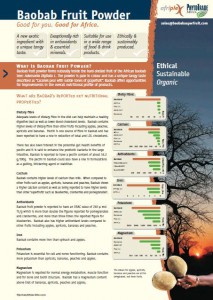 And you thought the world was safe from another baobab fact-sheet. Thanks, Ben Bennett.
And you thought the world was safe from another baobab fact-sheet. Thanks, Ben Bennett.
Nibbles: Meta-blogging, NUS scholarships, Insects & plant diversity, Commons, Trees and diet, Thyme, ABS
- Why they blog. At the Agriculture and Ecosystems Blog Agriculture and Ecosystems Blog that is. Can’t help thinking that the media should perhaps be alerted.
- Scholarships available at the Crops for the Future Research Centre.
- Yes, ok EurekAlert!, we get it , insects are really important to plant diversity.
- Yes, ok policy wonks, we get it, it’s really useful to see plant genetic resources as global commons.
- More tree cover means more diverse diet in Africa.
- Thyme, gentlemen, please.
- FAO Commission on Genetic Resources for Food and Agriculture Ad Hoc Technical Working Group on Access and Benefit-sharing for Genetic Resources for Food and Agriculture debates, well, access and benefit-sharing for genetic resources for food and agriculture. In Svalbard, of all places.
Nibbles: Cacao breeding, Specialy crops, Taihu pigs
- Breeding cacao in Ecuador.
- Supporting specialty crops in the US.
- Tasty Chinese piglets.
Brainfood: Wild barley drought tolerance, GM cassava retraction, Lupinus ploidy, Diversity levels
- SSR analysis of introgression of drought tolerance from the genome of Hordeum spontaneum into cultivated barley (Hordeum vulgare ssp vulgare). Scary thing is that only two wild accessions are involved.
- Transgenic Biofortification of the Starchy Staple Cassava (Manihot esculenta) Generates a Novel Sink for Protein. Fancy biotech puts more of a substance in cassava that nobody eats cassava for. No, wait.
- Whole genome duplication in a threatened grassland plant and the efficacy of seed transfer zones. Mixing of seed from different populations can be a good idea for conservation of rare plants, but not when they also differ in ploidy.
- Genetic diversity in widespread species is not congruent with species richness in alpine plant communities. Cannot use one as a proxy for the other.
Nibbles: Darwin herbarium, Saving seeds, Hunger Season, Grafting, Farmers’ rights, Vitamin A scandal, Plant hunting
- Did you know Darwin collected crop wild relative specimens on the Beagle?
- Saving the Running Conch. And its stories.
- Melinda Gates plugs “Hunger Season.” Including to AGRA, presumably.
- I want a fruit salad tree too.
- If you know how to implement Farmers’ Rights, the ITPGRFA would like to hear from you.
- Don’t keep taking the (vitamin A) pills.
- Hunters, pirates. You pays your money…